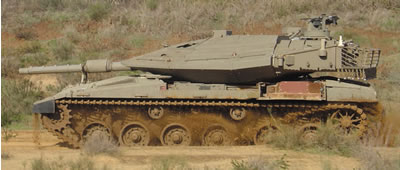Heavyweights are Adapting to LIC
Further improving the crew and commander’s operational capability under armor protection, the commander’s position has been augmented by a ring of panoramic vision blocks that provide a wide field of view. The addition of an independent commander’s sight fitted with a thermal imaging system, and its own full capability fire control computer, enables the commander and gunner to simultaneously and independently engage two disparate targets, thus multiplying the tank’s observation and fire coverage capabilities.
Further protection for the crew was considered by employing Autoflug safety seat systems, to protect the crew from side and bottom mine and IED blasts as well as reducing stress and fatigue during long duration missions. Several types of seats were tested in Merkava Mk4. The driver’s and commander’s seats utilized elevated designs, while the loader and gunner’s seat positions were fixed. However, seats are not used in serial production tanks. Autoflug safety seats are also being considered for use with the new Namer and various wheeled APCs under development by the IDF.
A remotely controlled weapon station mounting a 7.62 machine gun and a coaxial M2 heavy 12.7 mm machine gun above the main gun are also fully integrated into, and controlled through, the existing fire control system, enabling the Merkava crew to use either machine gun as a high powered sniper rifle for optimal pinpoint effect and accuracy at medium and short range.
The 60mm ‘under armor mortar’ will also be linked into the fire control system in order to provide automatic aiming and the use of extended range ammunition as part of the telescopic development spiral.
 Introduction of the new IMI Kalanit 120mm Anti-Personnel-Anti-Material (APAM) round for the main gun will further enhance the tank’s ability to engage dispersed infantry, buildings, and fortified structures as well as helicopters.
Introduction of the new IMI Kalanit 120mm Anti-Personnel-Anti-Material (APAM) round for the main gun will further enhance the tank’s ability to engage dispersed infantry, buildings, and fortified structures as well as helicopters.
A new addition, specifically designed for urban warfare, is the sniper’s position located at the rear access door. Firing through the protected porthole window a sniper can engage approaching tank killer teams advancing towards the vehicle’s most vulnerable area. Other improvements, designed specifically for urban combat include a rammer, which enables the tank to safely knock down obstructions, avoiding damage to the gun or optronics. A pre-installed tow chain harness is also used, to facilitates extraction and recovery of a disabled tank by another tank or a bulldozer, without exposing the crew.
Additional parts of this article:
- Merkava Mk 4 – IDF Continues Merkava Mk 4 Evolution
- Merkava Mk 4 – Firepower Improvements
- Merkava Mk 4 – Optronics and BMS
- Merkava Mk 4 – A Growing Family of AFVs
- Merkava Mk 4 – Promising Export Potential
Read more:





















